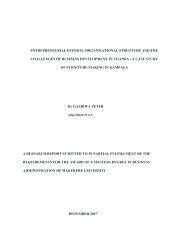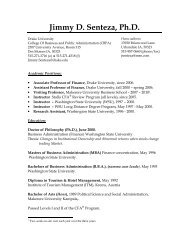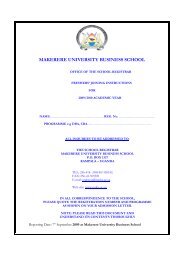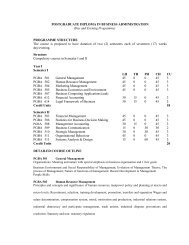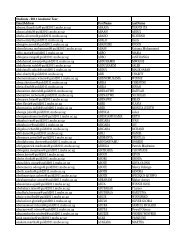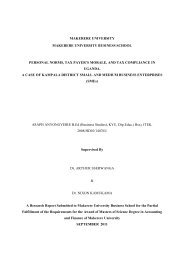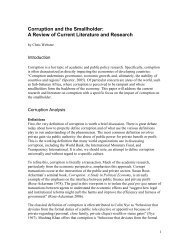13th Annual International Management Conference Proceeding
13th Annual International Management Conference Proceeding
13th Annual International Management Conference Proceeding
You also want an ePaper? Increase the reach of your titles
YUMPU automatically turns print PDFs into web optimized ePapers that Google loves.
4.2.3 Researches Services<br />
This is an area that is wanting (KIA, 2006-2011). The Institute is however, working around this<br />
inadequacy by having staff trained in research development and management is also encouraging more basic<br />
and action research initiatives (Figure III). Additionally, evidence for researches undertaken is now a<br />
requirement for upward mobility for the KIA faculty as an incentive while. In this year, the Institute<br />
undertook the first internal research conference in July where ten papers were presented. To date four (4)<br />
other researches have been completed, while three (3) are ongoing.<br />
4.3 Contribution of KIA towards Entrepreneurship Development in Kenya<br />
According to the 1999 Small and Micro Enterprise Baseline Survey, (GOK, 1999) there were about 1.3<br />
million MSEs employing an estimated 2.4 million people (Table 2).<br />
Table 2: Total Number of MSEs and their Employment by Area<br />
Nairobi and Mombasa<br />
Other Major towns<br />
Rural Towns<br />
Rural areas<br />
Total<br />
Area MSEs Workers<br />
Number % Number %<br />
204,280 15.8<br />
157,533 12.2<br />
81,320 6.3<br />
845,879 65.6<br />
1,289,012 100.0<br />
22<br />
394,838 16.9<br />
279,133 11.8<br />
135,34 5.6<br />
1,551,930 65.7<br />
2,361,250 100.0<br />
Source: GOK, Central Bureau of Statistics (CBS) <strong>International</strong> Center for Economic Growth (ICEG) and K-Rep<br />
Holdings Ltd., (1999:18). National Micro and Small Enterprise Baseline Survey 1999. Nairobi, Kenya.<br />
The 2003 National Economic Survey further shows that employment within MSE sector increased from 5.1 million<br />
persons in 2002 accounting for 74.2% of the total persons engaged in employment. This translates to 675, 000 jobs<br />
per year. The new entrants into the entrepreneurial job market obviously require support services that KIA provides.<br />
In addition, the sectoral analysis of wage employment in the modern sector as presented in Table 3 indicates an<br />
increase of the jobs in over the years including the self-employed where the MSE’s fall. Employment in the informal<br />
sector grows by 10.0% annually a catchment that KIA can induct.<br />
Table 3: Total Employment: June 2001-2005 (‘000’s)<br />
Modern Establishments- urban and Rural Areas: 2001 2002 2003 2004 2005<br />
Wage Employees 1.677.1 1.699.7 1.727.3 1.763.7 1.807.7<br />
Self-employed and unpaid family workers 65.4 65.5 65.7 66.3 66.8<br />
Informal Sector 4,668.7 5,108.3 5,546.4 5,992.8 6,407.2<br />
TOTAL 6,411.2 6,873.5 7,339.4 7,822.8 8,281.7<br />
Source: GOK, Central Bureau of Statistics Ministry of Planning and National Development. (2006). Economic<br />
Survey 2006. Government Printer Nairobi.<br />
The MSE sector substantially provides employment for more (over 74.2% of the total number of persons engaged in<br />
the country) people than does the formal sector. The average Kenyan MSE employs 1-2 workers. The sector<br />
contributes up to 18.4% of the country’s Gross Domestic Product (GDP) and is also a driver in promoting enterprise<br />
culture, necessary for achieving the national goal of employment, wealth creation and development (GOK, 2005). The<br />
average income of the enterprises surveyed was Kenya Shillings (Ksh). 6,000 per month or 2.5 times higher than the<br />
minimum monthly wage for general labourers (which in 1999 was Ksh. 2,363). However, among the main constraints<br />
facing micro-entrepreneurs was lack of skilled personnel a gap that KIA with others in the support system have been<br />
striving to fill, but more input is required.<br />
Contrary to the belief, that mushrooming SMEs are an epitome of an enterprise culture in Kenya, the key factors<br />
behind this phenomenal growth are desire to supplement income, availability of credit, the desire to generate wealth



